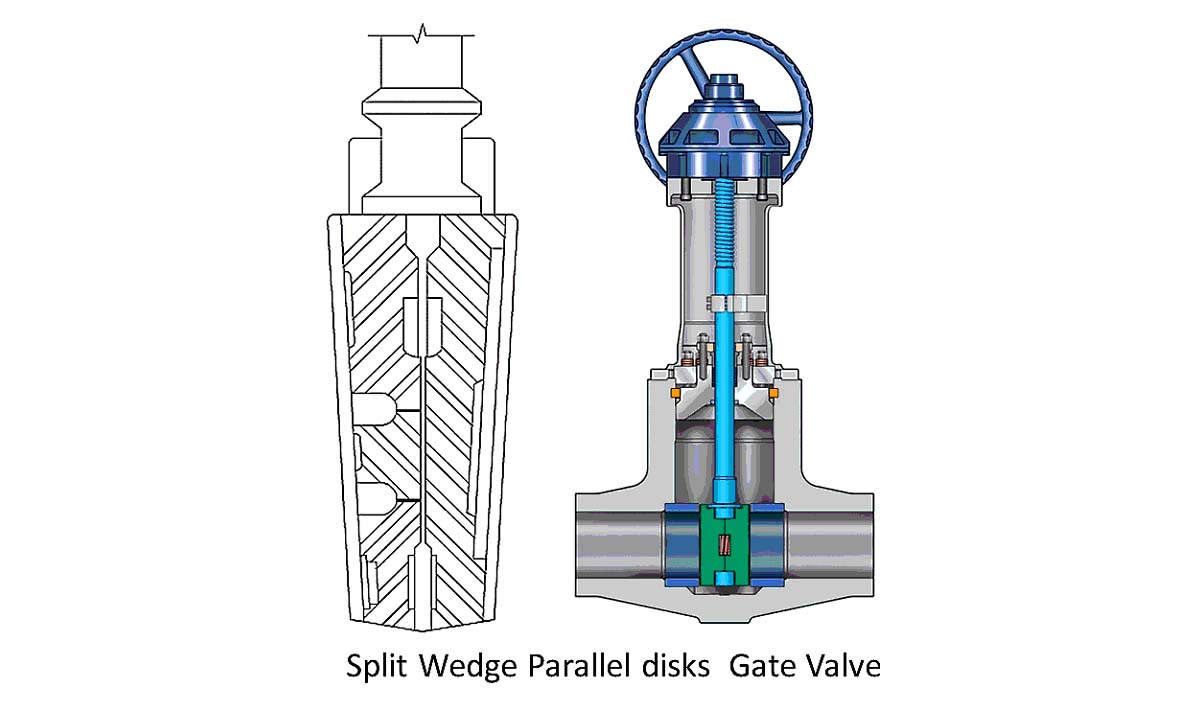A split wedge gate valve, also known as a split disc gate valve, is a type of gate valve that uses a two-piece wedge assembly to provide improved sealing and flexibility in pipelines with temperature variations and alignment issues. Its ability to self-adjust under pressure makes it ideal for a wide range of medium- to high-pressure applications.

Table of Contents
Toggle🔧 What Is a Split Wedge Gate Valve?
Unlike the solid wedge, which consists of a single disc, a split wedge gate valve uses two separate discs that are held together by a hinge or spacer. This design allows the discs to move slightly and self-align with the seat surfaces, improving sealing even when the pipeline experiences thermal expansion, contraction, or slight seat misalignment.
🛠️ Key Features
Two-piece wedge disc connected by a hinge pin or spacer
Self-adjusting to seat misalignments and pressure fluctuations
Tight shutoff in both directions
Reduced seat wear compared to solid wedge designs
Reliable performance under high-temperature and high-pressure conditions
📌 Common Applications
Split wedge gate valves are used across a variety of demanding industries, especially where temperature fluctuations or slight piping misalignments are present:
Power plants (especially steam and high-temperature systems)
Petrochemical and oil & gas
Refineries
Pulp and paper industries
High-pressure steam systems
Process industries requiring tight shutoff and reduced seat wear
🧱 Materials of Construction
| Component | Common Materials |
|---|---|
| Body/Bonnet | Carbon steel, alloy steel, stainless steel |
| Wedge Discs | Forged steel, stainless steel, hard-faced alloys |
| Seats | Stainless steel, Monel, Stellite |
| Stem | Stainless steel, Cr-Mo alloy |
✅ Advantages of Split Wedge Gate Valves
Excellent seat alignment: Each half of the disc can conform to the seat independently
Less seat damage: Reduced risk of binding or galling
Ideal for high-temperature applications: Handles thermal expansion better than solid wedges
Improved tightness over time due to self-seating action
Better sealing in older or slightly worn valve bodies
⚠️ Limitations
More complex design than solid wedge valves, potentially higher maintenance
Hinge/spacer mechanism is a potential wear point
Not suitable for slurries or fluids with solids, as particles can get trapped between the discs
More expensive compared to solid wedge types
🔍 Split Wedge vs Solid Wedge vs Flexible Wedge
| Feature | Solid Wedge | Flexible Wedge | Split Wedge |
|---|---|---|---|
| Sealing Adjustment | Rigid | Some flexibility | High flexibility |
| Thermal Expansion | Poor | Good | Excellent |
| Misalignment Tolerance | Low | Moderate | High |
| Complexity | Low | Medium | High |
| Cost | Low | Moderate | Higher |
| Recommended Use | Clean, stable systems | Moderate conditions | High-temp/pressure systems |
🔚 Conclusion
The split wedge gate valve is a high-performance solution for industrial applications where tight shutoff, self-alignment, and temperature variability are critical concerns. Though more complex than solid or flexible wedges, it offers superior longevity, sealing performance, and operational reliability in challenging conditions.
When choosing the right gate valve, understanding the fluid type, pressure, temperature, and installation environment is essential. For dynamic systems with thermal changes or misalignment potential, the split wedge gate valve is often the best fit.
